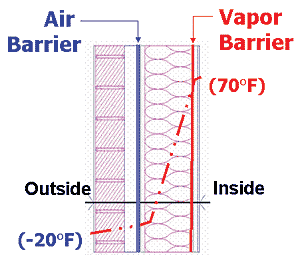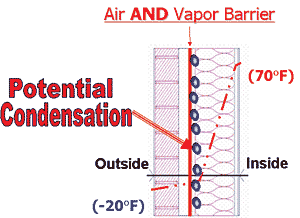Air Barriers: Increasing Building Performance, Decreasing Energy Costs
Additional Application Methods
In addition to the three main types of air barriers previously noted, other application methods include Sprayed Polyurethane Foams (SPF) and torch-applied membranes. The choice of air barriers based on the application method is often a personal or regional preference, which takes into account the ease of application on certain back-up walls, the material availability and cost, the familiarity of the designer, specifier or contractor with certain products and manufacturers, and access to certified installers.
Vapor Permeable Versus Vapor Non-Permeable Air Barriers
Based on vapor permeability, air barrier materials are classified into vapor permeable and vapor non-permeable. The vapor permeability of building materials has implications on the ability of the building enclosure to manage the moisture loadings: vapor permeable materials allow diffusion, while vapor non-permeable materials do not allow diffusion. Although moisture movement by diffusion cannot be discounted as a wetting source, diffusion is much more critical as a drying mechanism. This is true of all building materials. Mechanically fastened membranes are vapor permeable; some fluid applied membranes have limited vapor permeability; all others are vapor non-permeable. The vapor permeability will dictate the air barrier placement in the building assembly: vapor permeable air barriers can be placed anywhere in the assembly, while vapor non-permeable air barriers must generally be installed on the warm side of the assembly, in order to avoid condensation.
Cold Climate Case Studies
To understand how the wall assembly design and climate affect the selection of an air barrier, consider a cold climate example, in Minneapolis, Minnesota, with a traditional cavity insulation wall design. The air barrier for these walls is typically installed on the exterior face of the exterior sheathing. The next figure describes how a vapor permeable air barrier works in this assembly for this climate.
|
The exterior air barrier will protect the wall cavity against liquid water intrusion and air infiltration, but will allow drying from incidental moisture to the outside.
In this climate, the predominant driving force for vapor diffusion, hence the preferred drying direction, is from the inside to the outside. In addition, a vapor barrier on the interior side of the wall cavity would protect against moisture vapor diffusion from the inside. Here, the inside air is predominantly warmer and wetter than the outside air. This cold climate example shows that the use of an exterior vapor permeable air barrier, in conjunction with an interior vapor barrier, is a good practice.
A vapor non-permeable air barrier installed on the exterior face of the exterior sheathing would perform differently with this wall assembly, in this climate. The vapor non-permeable air barrier combines the functions of air barrier and vapor barrier into a single membrane. The membrane will protect the wall cavity against liquid water intrusion and air infiltration; however, because the membrane is vapor non-permeable (vapor barrier), it will not allow drying from incidental moisture to the outside, because in this climate the predominant driving force for vapor diffusion is from the inside to the outside. In addition, the vapor barrier would be located on the cold side of the insulation, leading to potential condensation. This example shows why vapor non-permeable air barriers (air and vapor barriers) should not be used in this climate with the interior insulation wall assembly.
|











